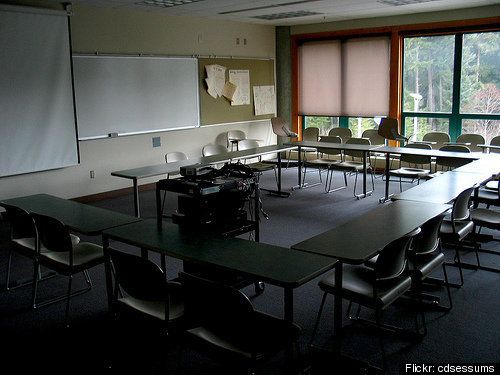
Note: This guest post comes from Morgan E. Arenson, a program officer for digital media and learning initiatives at the Woodrow Wilson National Fellowship Foundation.
American schools can expect transformation on an unprecedented scale in the coming decades. Today, schools are out of date. They work on an industrial model, which is built around students taught in lockstep, rather than a technological one, which focuses on individual students and connects them to their learning materials, to each other, and to their teachers in new ways. Schools today do not take into account the changing professional world that more than ever relies both on individual effort and networked teams. In an increasingly competitive global economy, American students are not performing well compared to those in many other nations. And rather than harnessing technologies that have become ubiquitous in young people's lives, American schools often avoid or even forbid them.
Educators must respond to these problems by making some significant changes. To move away from the industrial model, schools must shift the emphasis from teaching to learning and from common time to common outcomes. Education must be individualized to ensure pedagogy matches individual students' learning styles and students achieve the intended outcomes. Teachers' roles must change; they must diagnose students' learning styles, prescribe what material to give individual students to match their learning needs, and assess how students are progressing towards the desired, high-level outcomes. The question is how these changes will occur, and there are two possibilities.
First, this change could be top-down, an effect of administrators and policy makers looking for efficiencies due to economic and political pressure. This approach leads to a greater proliferation of online courses, which are an obvious place to start saving money and which offer greater flexibility for students to take more courses at lower costs to districts. It also leads to greater overall investment in technology, primarily in ways that replicate what already happens in classrooms, like making textbooks digital and moving science labs into virtual worlds. In some states, testing has already gone online.
Second, this change could be bottom-up, driven by teachers or even students. Introducing digital media in the classroom gives teachers a chance to use the skills and excitement students have for digital media, adapting ways that young people use technology to learn already, like games, social networks, and interest-driven learning communities. Because this approach draws on informal learning practices, it requires significant rethinking of how to measure outcomes -- work that has been a priority for some reformers already -- but also raises questions about how to structure classrooms and schools. There is more work to do to figure out how this model works best, particularly around pedagogy and assessment. But new technologies that change how students experience learning offer some tantalizing possibilities and are far more likely to produce the kinds of graduates who will be prepared for college and the workplace.
Given these two options, which approach is better?
The answer must be both. The school system needs to catch up to the 21st century by exploring what technology can do at the state, district, school, and class levels. The structural changes that the first method suggests are necessary, and in fact they are already happening. Some experts, like Harvard's Clayton Christensen, predict that as many as half of the courses taken in high school will be online courses by 2019. School of One, in New York City, has taken this model to the extreme, instituting individual schedules for its students that designate class, individual, and small-group work time for each student, as well as setting daily individual online work at the student's learning level and embedding assessment in those programs.
Pedagogy is also changing, as educators and scientists learn more about how young people learn, often drawing on how they learn informally about what interests them. After-school programs, like YouMedia in Chicago and Global Kids -- both of which use digital tools heavily to help students learn -- are finding new ways to engage urban teens in social issues while teaching them skills that will serve them well in school and in their professional lives. Quest to Learn, another new school in New York City, is the expansion of an after-school program, Institute of Play, that takes a game and design approach to a 6th-12th grade curriculum.
Innovative curricula and pedagogy will need structures to support and organize them. Similarly, new structures that rely on more technology will need to assure that they fulfill their potential to meet the learning needs of every student. This is the challenge for today and for the next 20 years. We need to put resources behind new technology, programs, and applications; evaluate them by how much they increase what our young people learn; improve the weaker pieces; and then scale what works.
